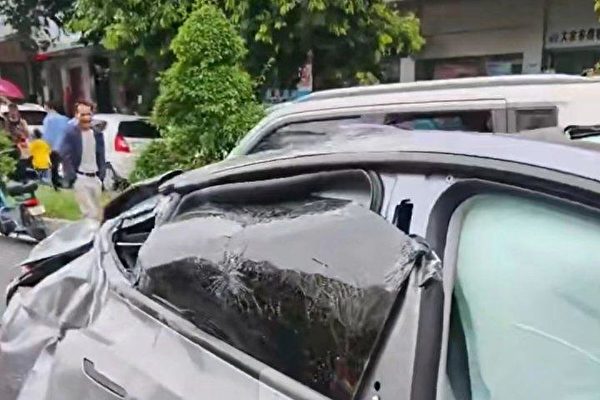Recently, a Tesla electric car in Dayu County, Jiangxi Province, reportedly lost control on the street due to improper operation. The vehicle sped up, flipped multiple times in the air, and collided with several cars, resulting in severe damage to the car but miraculously leaving the two occupants unharmed. Many Chinese netizens quickly drew comparisons with a previous incident involving a Huawei Wanzai electric car that rear-ended a water sprinkler truck, causing a fiery crash that claimed three lives. Netizens sarcastically remarked, “Now you know who is ‘leading ahead,’ right?”
According to a viral video circulating online, on Nan’an Avenue in Dayu County, Ganzhou City, Jiangxi Province, a runaway Tesla Model Y rolled over more than 10 times, causing extensive damage to several cars and injuries to multiple pedestrians. Both the female driver and the male passenger suffered varying degrees of injuries, with the driver’s foot suspected to be trapped, visibly in pain while the passenger remained composed, even texting and making calls amidst the onlookers. Blood stains could be seen on their faces and hands.
As reported by Urban Express Interactive, the accident occurred around 2:30 pm on May 1st at the intersection of Nan’an Avenue and Beiwai Road in Dayu County, Ganzhou City, situated about 60 meters southeast of a roundabout. The triangular area near the roundabout, serving as a small parking lot, housed over 20 private cars and a van.
A video captured by an on-site dashcam shows the Tesla soaring through the air from a distance, tumbling more than 10 times before colliding with the parked vehicles in the lot.
A netizen claiming to have been present at the scene shared a diagram depicting the rolling trajectory of the Tesla during the accident.
The out-of-control Tesla, identified as a Model Y, was unlicensed and suffered severe damage, with the front bumper missing, the roof almost completely caved in, the right rear tire detached from the hub, the hood severely deformed and protruding, the front windshield shattered, and the front airbags and side curtains of all four windows deployed.
The accident left several pedestrians injured, with at least two victims lying on the ground in the video. The impacted vehicles also sustained significant damage, with some having deformed hoods, smashed fronts, severely twisted rears, and scattered car parts and bumpers strewn across the scene.
The Dayu County Public Security Bureau reported on the evening of May 1st that the accident resulted in “one person severely injured, three lightly injured, and nine vehicles damaged. The cause of the crash was cited as emergency avoidance maneuver executed improperly.”
The Tesla electric car accident quickly became a hot topic on mainland China’s internet. However, many netizens juxtaposed this incident with the tragic case where a Huawei Wanzai M7 electric car rear-ended a vehicle, leading to a fatal fire, killing all three occupants, prompting questions about Huawei’s accountability.
Some netizens pointed out that despite the Tesla flipping multiple times in the air, the occupants’ lives were saved, and the car did not catch fire, with airbags deployed, implying a stark contrast to the previous tragic incident involving the Huawei car.
Furthermore, netizens sarcastically remarked, “Now you know who is ‘leading ahead,’ right?”
On April 26th, a jointly developed electric car by Huawei and Seres, the “Wanzai M7 Plus,” caught fire after rear-ending a vehicle on a highway in Yuncheng, Shanxi Province, leading to the deaths of three occupants. Videos and articles raising questions about the incident were swiftly removed, sparking further skepticism.
Video footage showed that prior to the rear-end collision, the vehicle’s automatic emergency braking system (AEB) was not engaged, and after the accident, the doors failed to unlock automatically, impeding rescue efforts and garnering widespread criticism.
A commentary published by the Guangdong Southern Newspaper Group’s “21st Century Economic Report” questioned whether Huawei’s Wanzai AEB (Active Emergency Braking) system was overhyped in its promotion, highlighting that emphasizing being ‘far ahead’ should not come at the cost of lives. The article was later taken down.
The article highlighted how under the influence of Yu Chengdong’s “far-ahead” statement, many car manufacturers were compelled to follow suit, falling into the trap of excessive advertising. Huawei’s actions sounded a warning to the industry about the repercussions of irresponsible excessive promotion, affecting not only users but also leading to backlash against themselves.
On April 30th, a rumored “21st Century Economic Report retraction letter” circulated online, indicating that the publication had requested various media websites to delete the aforementioned report. Clearly, China’s largest mainstream financial media outlet faced pressure from CCP propaganda agencies.
In response, commentator Wang Yajun observed that Huawei’s “stability maintenance” force was far ahead of its peers, with the backing of the CCP’s Central Committee, which raised concerns about the responsible parties involved in the incidents.

